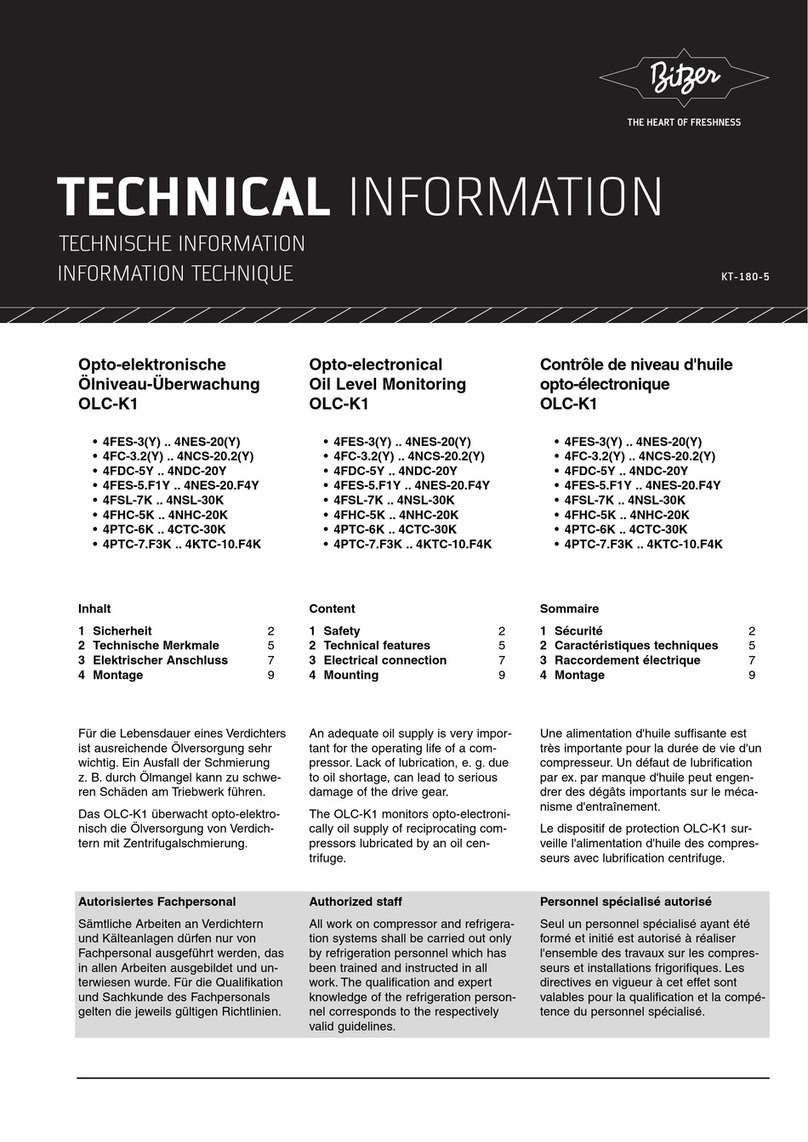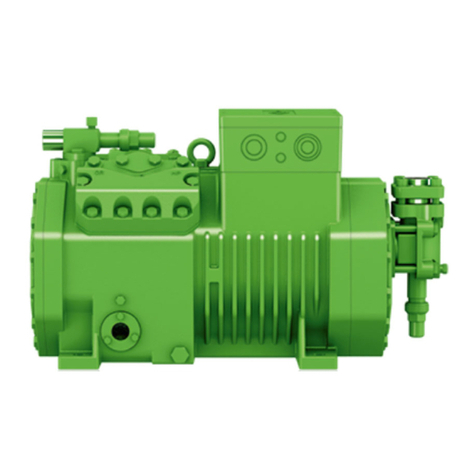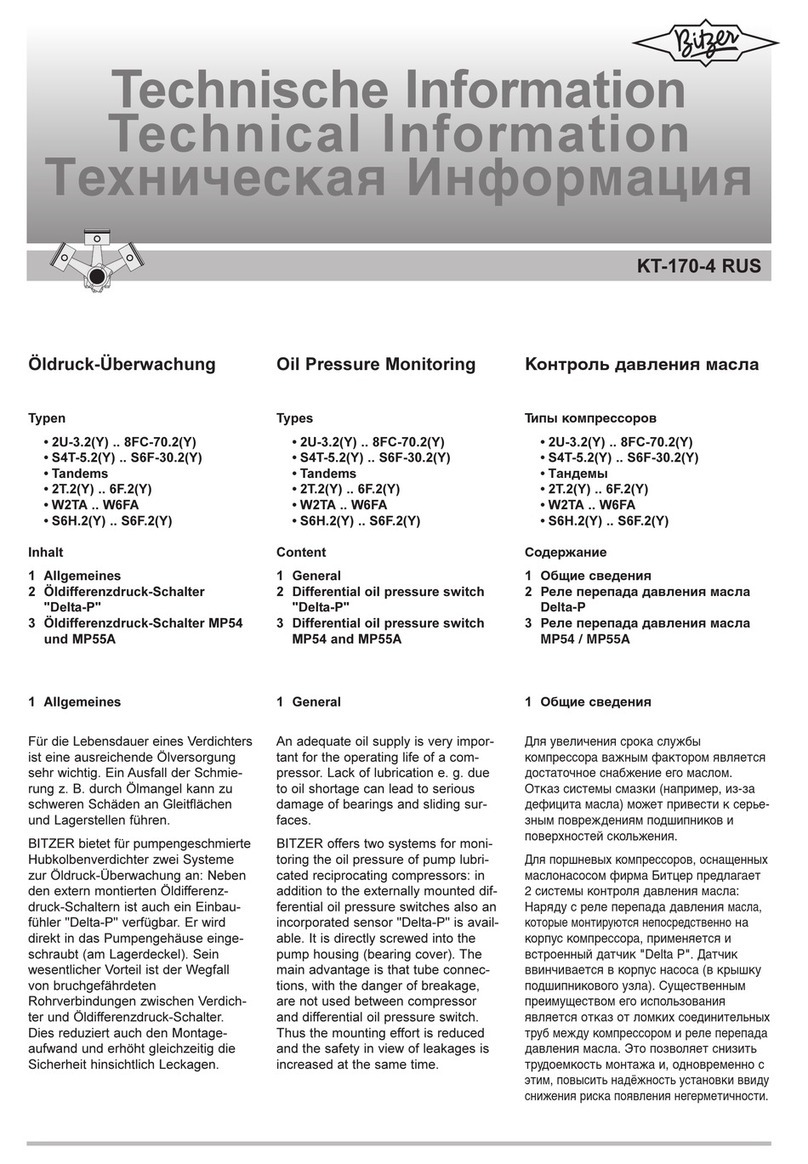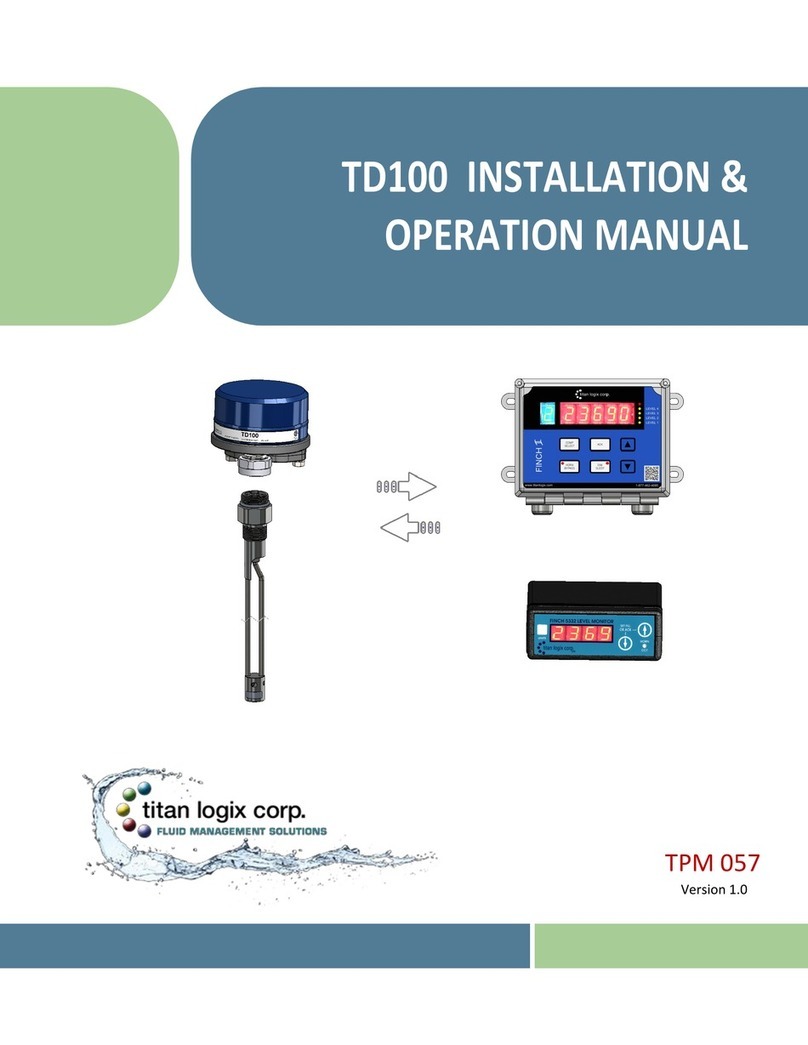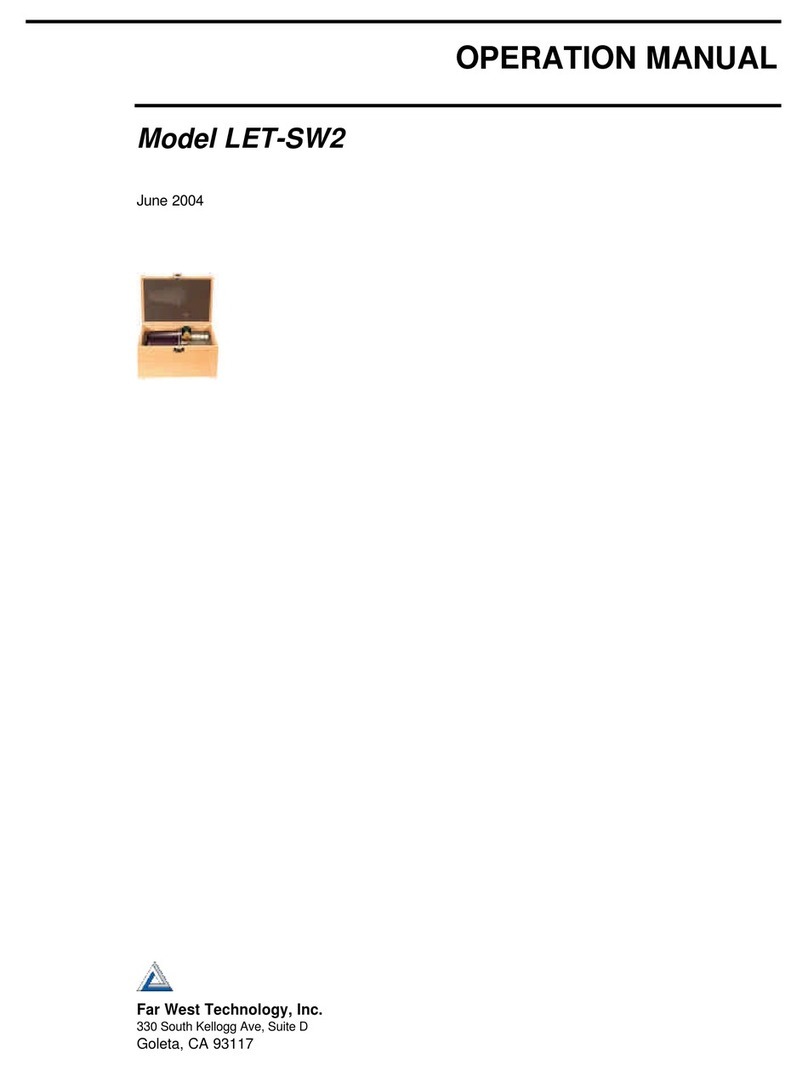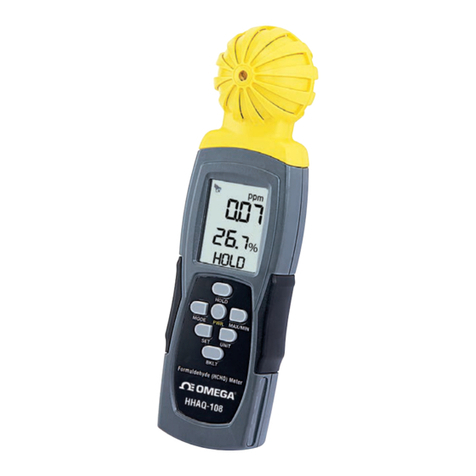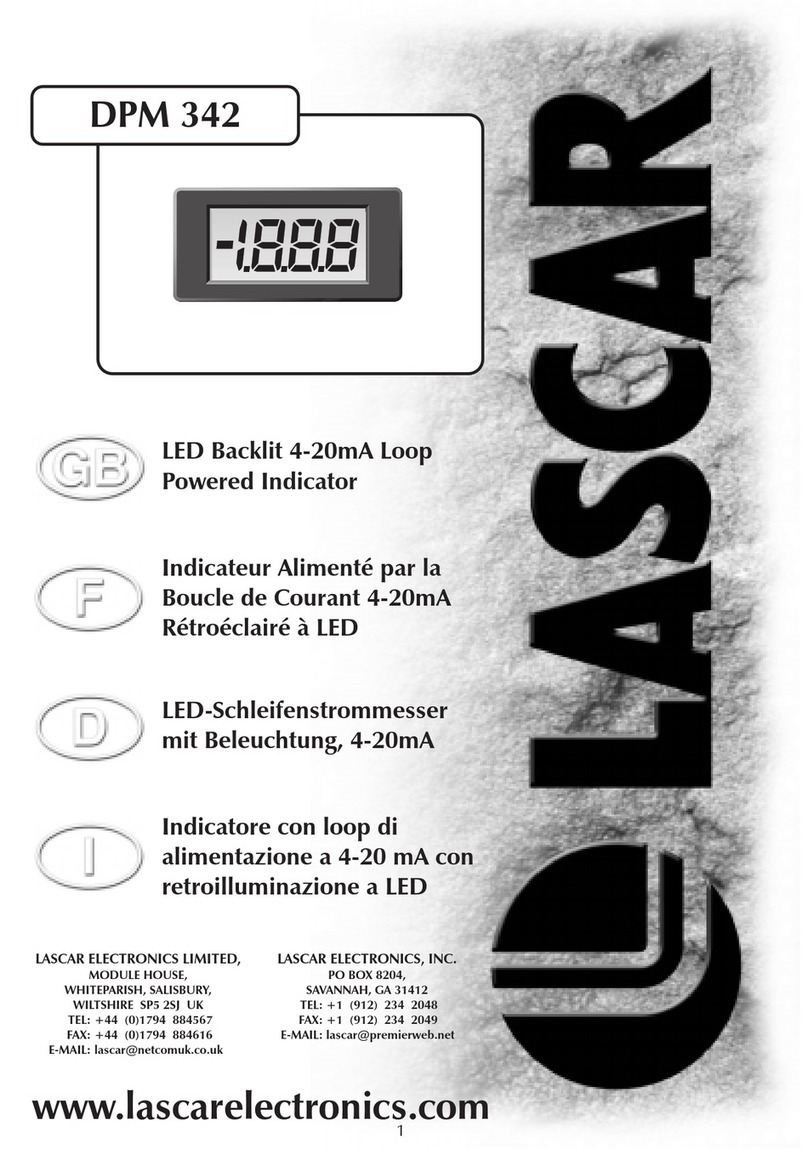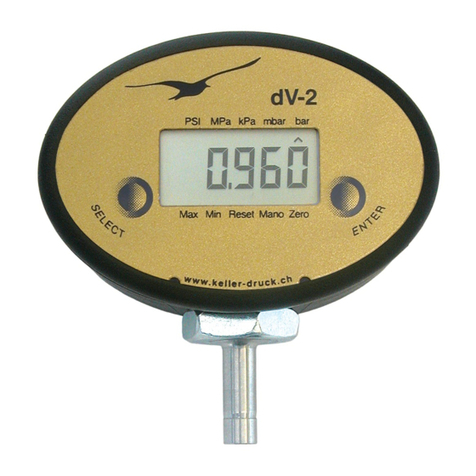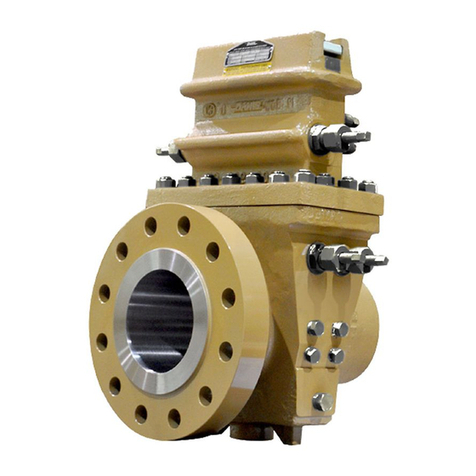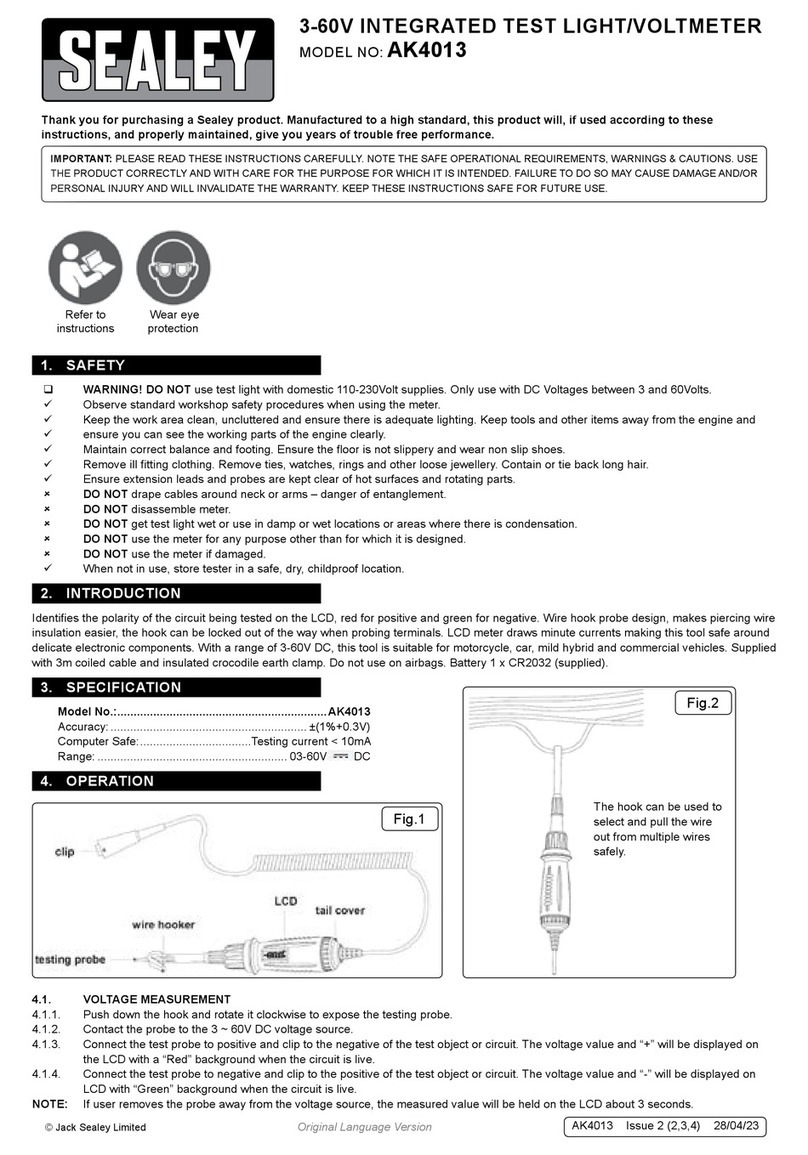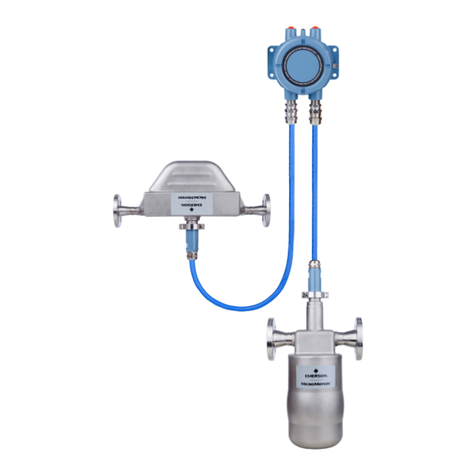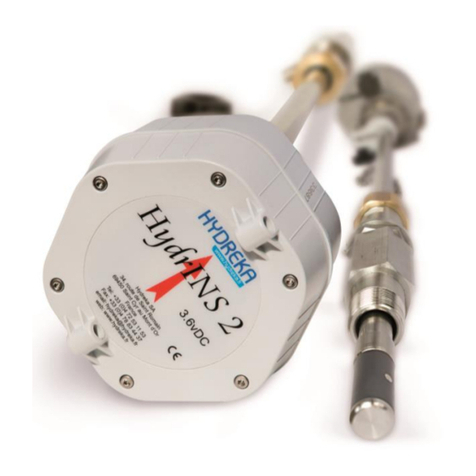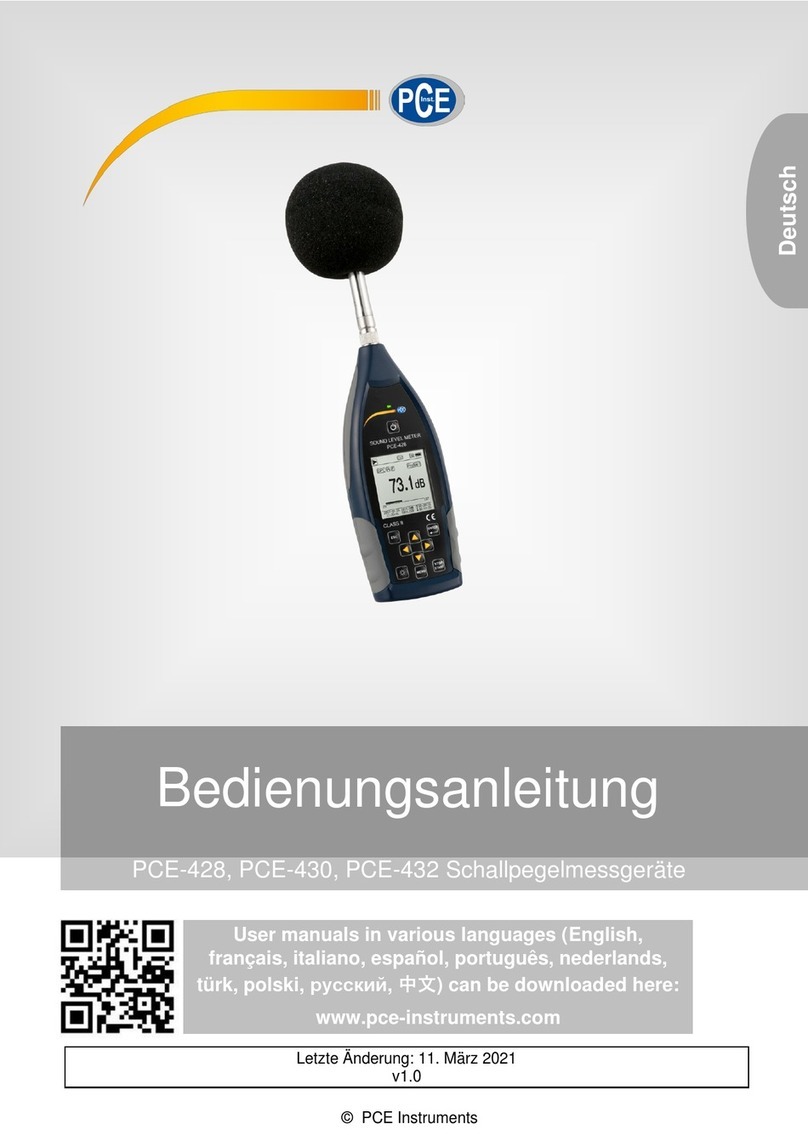Bitzer SE-C1 Manual

Schutzgeräte
SE-C1 und SE-C2
für Schraubenverdichter
Inhalt
1 SE-C1 und SE-C2
2 Überwachungsfunktionen
3 Funktions- und Störmeldungen
4 Technische Daten
5 Prinzipschaltbilder
1 SE-C1 und SE-C2
Diese optionalen Schutzgeräte über-
wachen mehrere Betriebs-Parameter
und schützen so den Verdichter über
die allgemein üblichen Kontrollfunkti-
onen hinaus.
Zusätzlich zu den Funktionen des
Standard-Schutzgeräts SE-E1 (Über-
wachung von Motor- und Druckgas-
Temperatur, Drehrichtung und Pha-
senausfall vgl. ST-120) überwachen
SE-C1 und SE-C2 noch die Phasen-
symetrie, Schalthäufigkeit und Ölver-
sorgung. Sie ersetzen die Schutzgerä-
te SE-E1, INT389R sowie OFC bei
HS- und OS-Schrauben.
Das SE-C1 ist für die CSH- und die
HS.64/74-Schrauben und das SE-C2
speziell für HS.85-Verdichter konzi-
piert.
Die Schutzgeräte arbeiten über einen
großen Spannungsbereich. Dies er-
laubt den Einsatz in nahezu allen
Stromnetzen (50 und 60 Hz) sowie
eine Überwachung von Verdichtern im
Frequenzumrichter-Betrieb. Ein Vor-
schaltgerät für den Betrieb von Son-
dermotoren für 575 und 690 V ist
nicht erforderlich.
Protection Devices
SE-C1 and SE-C2
for Screw Compressors
Content
1 SE-C1 and SE-C2
2 Monitoring functions
3 Functional and failure messages
4 Technical data
5 Schematic wiring diagrams
1 SE-C1 and SE-C2
These optional protection devices
monitor several operational parame-
ters to protect the compressor beyond
the standard control functions.
SE-C1 and SE-C2 offer all functionali-
ty provided by the standard protection
device SE-E1 (monitoring of motor
and discharge gas temperatures, rota-
tion direction and phase failure, see
ST-120), but also monitor phase sym-
metry, switching frequencies and oil
supply. They replace the protection
devices SE-E1, INT389R and OFC for
HS and OS screws.
The SE-C1 is designed for CSH and
HS.64/74 screws, the SE-C2 especial-
ly for the HS.85 compressors.
The protection devices work over a
large voltage range. This allows the
use in nearly all power supply sys-
tems (50 and 60 Hz), as well as for
monitoring compressors with frequen-
cy inverters. A step down resistor
device for the operation of special
motors for 575 and 690 V is not
required.
Dispositifs de protection
SE-C1 et SE-C2
pour les compresseurs à vis
Sommaire
1 SE-C1 et SE-C2
2 Fonctions de contrôle
3 Fonctions et pannes signalées
4 Caractéristiques techniques
5 Schémas de principe
1 SE-C1 et SE-C2
Ces dispositifs de protection optionnaux
contrôlent plusieurs paramètres de fonc-
tionnement et protègent aussi le com-
presseur au-delà des fonctions de contrô-
le usuelles.
En plus des fonctions du dispositif de pro-
tection standard SE-E1 (contrôle de la
température moteur et du gaz de refoule-
ment, sens de rotation et défaut de
phase, voir ST-120) sont supplémentés
par des fonctions des SE-C1et SE-C2:
surveillance de la symétrie des phases,
de la fréquence d'enclenchement et d'ali-
mentation en huile. Ils remplacent les dis-
positifs de protection SE-E1, INT389R et
OFC pour des vis HS et OS.
Le SE-C1 a été conçu pour les vis CSH
et HS.64/74, le SE-C2 spécialement pour
les compresseurs HS.85.
Les dispositifs de protection couvrent une
large plage de tensions. Ils sont donc uti-
lisables sur pratiquement tous les
réseaux électriques (50 et 60 Hz) ainsi
que pour le contrôle des compresseurs
avec convertisseur de fréquences. Un
transformateur pour le fonctionnement
des moteurs spéciaux pour 575 et 690 V
n'est pas nécessaire.
ST-121-2
Technische Information
Technical Information
Information Technique

2
2 Monitoring functions
SE-C1 monitors
(CSH, HS.64 & HS.74)
• CSH: motor and oil temperature
HS.64 and HS.74: motor and dis-
charge gas temperature
• PTC measuring circuit
• Wrong rotation direction, phase fail-
ure and phase asymmetry (voltage
interruption)
• Maximum switching frequency
• Oil level (only CSH compressors
• Oil flow (only HS.64 und HS.74)
SE-C2 monitors (HS.85)
• Motor and discharge gas tempera-
ture
• PTC measuring circuit
• Wrong rotation direction, phase fail-
ure and phase asymmetry (voltage
interruption)
• Maximum switching frequency
• Oil supply
• Oil stop valve
2.1 Temperature monitoring
SE-C1 / CSH, HS.64 and HS.74:
PTC resistances in motor winding and
oil temperature (CSH) or discharge
gas outlet (HS.64 & HS.74)
SE-C2 / HS.85:
PTC resistances in motor winding and
discharge gas outlet
The protection devices lock out imme-
diately if the maximum allowable tem-
perature is exceeded.
Reset manually after cool-down.
2.2 Monitoring of the PTC measur-
ing circuit
The protection devices monitor the
PTC measuring circuit (for short cir-
cuits or cable / sensor failure). In case
of voltage interruption or short circuit,
they lock out immediately.
• Terminals 5 and 6 at protection
device (PTC, fig. 1 and 2)
• Determine cause and eliminate.
Reset manually afterwards.
2 Fonctions de contrôle
SE-C1 surveille
(CSH, HS.64 & HS.74)
• CSH: température du moteur et d'huile
HS.64 et HS.74: température du
moteur et de gaz de refoulement
• Boucle de mesure CTP
• Sens de rotation, défaut de phase et
de l'asymétrie (interruption de tension)
• Fréquence maximale d'enclenchement
• Niveau d'huile (seulement vis CSH)
• Contrôle de débit d'huile (seulement
HS.64 et HS.74)
SE-C2 surveille (HS.85)
• Température du moteur et de gaz de
refoulement
• Boucle de mesure CTP
• Sens de rotation, défaut de phase et
de l'asymétrie (interruption de tension)
• Fréquence maximale d'enclenchement
• Alimentation d'huile
• Vanne de retenue d'huile
2.1 Contrôle de la température
SE-C1 / CSH, HS.64 et HS.74:
résistances CTP dans bobinages du mo-
teur et température d'huile (CSH) ou sor-
tie gaz de refoulement (HS.64 & HS.74)
SE-C2 / HS.85:
résistances CTP dans bobinages du
moteur et dans sortie du gaz de refoule-
ment
En cas de dépassement des tempéra-
tures maximales autorisées, les disposi-
tifs de protection verrouillent immédiate-
ment.
Déverrouiller manuellement après refroi-
dissement.
2.2 Contrôle de la boucle de mesure
CTP
Les dispositifs de protection contrôlent la
boucle de mesure CTP (court-circuit ou
rupture fil / sonde). En cas d'interruption
de tension ou court-circuit, ils verrouillent
immédiatement.
• Bornes 5 et 6 sur dispositif de protec-
tion (CTP, fig. 1 et 2)
• Déterminer la cause et y remédier.
Ensuite déverrouiller manuellement.
2 Überwachungsfunktionen
SE-C1 überwacht
(CSH, HS.64 & HS.74)
• CSH: Motor- und Öltemperatur
HS.64 und HS.74:
Motor- und Druckgas-Temperatur
• PTC-Messkreis
• Falsche Drehrichtung, Phasenaus-
fall und Phasenasymetrie (Span-
nungsunterbrechung)
• Maximale Schalthäufigkeit
• Ölniveau (nur CSH-Verdichter)
• Öldurchfluss (nur HS.64 und
HS.74)
SE-C2 überwacht (HS.85)
• Motor- und Druckgas-Temperatur
• PTC-Messkreis
• Falsche Drehrichtung, Phasenaus-
fall und Phasenasymetrie (Span-
nungsunterbrechung)
• Maximale Schalthäufigkeit
• Ölversorgung
• Ölstoppventil
2.1 Temperatur-Überwachung
SE-C1 / CSH, HS.64 und HS.74:
PTC-Widerstände in Motorwicklung
und Öltemperatur (CSH) bzw. Druck-
gasaustritt (HS.64 & HS.74)
SE-C2 / HS.85:
PTC-Widerstände in Motorwicklung
und Druckgasaustritt
Die Schutzgeräte verriegeln sofort,
wenn die maximal zulässigen Tempe-
raturen überschritten werden.
Nach Abkühlung manuell entriegeln.
2.2 Überwachung des PTC-Mess-
kreises
Die Schutzgeräte überwachen den
PTC-Messkreis (auf Kurzschluss oder
Leitungs- / Fühlerbruch). Bei Span-
nungsunterbrechung oder Kurz-
schluss verriegeln sie sofort.
• Klemmen 5 und 6 am Schutzgerät
(PTC, Abb. 1 und 2)
• Ursache ermitteln und beseitigen.
Danach manuell entriegeln.
ST-121-2

3
2.3 Überwachung von Phasen-
ausfall, Asymetrie und Dreh-
richtung
Bei Phasenausfall oder unzulässig
hoher Phasenasymetrie unterbrechen
die Schutzgeräte den Relaiskontakt in
der Sicherheitskette und schließen ihn
nach 6 Minuten wieder.
Sie verriegeln nach:
• 3 Phasenausfällen oder zu hoher
Phasenasymetrie innerhalb von
40 Minuten
• 10 Phasenausfällen oder zu hoher
Phasenasymetrie innerhalb von
24 Stunden
Bei falscher Drehrichtung verriegeln
die Schutzgeräte sofort.
Ursache ermitteln und beseitigen.
Danach manuell entriegeln.
2.4 Überwachung der maximalen
Schalthäufigkeit
Die Schutzgeräte begrenzen den Zeit-
raum zwischen zwei Verdichterstarts
auf mindestens 12 Minuten (Summe
aus Lauf- und Stillstandszeit) bzw. auf
mindestens 3 Minuten Stillstandszeit
nach längerer Betriebsphase.
Nach Ablauf der Verzögerungszeit
entriegeln die Schutzgeräte automa-
tisch.
2.5 Ölniveau-Überwachung
SE-C1 / CSH
Der Ölniveau-Wächter ist bei CSH-
Schrauben eine Option (siehe Projek-
tierungs-Handbuch SH-170).
• Klemmen 1 und 2 am SE-C1 (oil
level, Abb. 1)
Wenn eine Ölniveau-Störung länger
als 90 Sekunden andauert, schaltet
das SE-C1 den Verdichter ab. Nach
12 Minuten entriegelt es automatisch.
Nach der 4. Ölniveau-Störung inner-
halb von 50 Minuten verriegelt das
SE-C1.
• Ursache ermitteln und beseitigen.
Danach manuell entriegeln.
Sollte Ölniveau-Überwachung nicht
vorgesehen sein, dann muss zwi-
schen den Klemmen 1 und 2 am
SE-C1 eine Brücke eingebaut werden.
2.3 Monitoring of phase failure,
asymmetry and rotation direc-
tion
In the case of phase failure or unac-
ceptably high phase asymmetry, the
protection devices interrupt the relay
contact in the safety chain and close it
again 6 minutes later.
They lock out after:
• 3 phase failures or too high phase
asymmetry within 40 minutes
• 10 phase failures or too high phase
asymmetry within 24 hours
In the case of wrong rotation direction
the protection devices lock out imme-
diately
Determine cause and eliminate.
Reset manually afterwards.
2.4 Monitoring of maximum switch-
ing frequency
The protection devices limit the time
between two compressor starts to at
least 12 minutes (sum of operating
and standstill times) and to at least
3 minutes of standstill time after a
longer operating phase.
Once the delay time has passed, the
protection devices reset automatically.
2.5 Oil level monitoring
SE-C1 / CSH
The oil flow switch is optional for CSH
screws (see Applications Manual
SH-170).
• terminals 1 and 2 at SE-C1 (oil
level, fig. 1)
If an oil level failure lasts longer than
90 seconds, the SE-C1 shuts off the
compressor. After 12 minutes it resets
automatically.
After the 4th oil level failure in 50 min-
utes the SE-C2 locks out.
• Determine cause and eliminate.
Reset manually afterwards.
In case oil level monitoring is not
intended, a bridge must be placed
between terminals 1 and 2 at SE-C1.
2.3 Contrôle de l'asymétrie et du
défaut de phase et du sens de
rotation
En cas de défaut de phase ou d'asymé-
trie de phase trop importante, les disposi-
tifs de protection ouvrent le contact du
relais dans la chaîne de sécurité, et le
referment après 6 minutes.
Ils verrouillent après:
• 3 défauts de phase ou asymétrie de
phase trop haute en l'espace de
40 minutes.
• 10 défauts de phase ou asymétrie de
phase trop haute en l'espace de
24 heures.
En cas de mauvais sens de rotation, les
dispositifs de protection verrouillent
immédiatement.
Déterminer la cause et y remédier.
Ensuite déverrouiller manuellement.
2.4 Contrôle de la fréquence d'enclen-
chement maximale
Les dispositifs de protection fixent l'inter-
valle entre deux démarrages successifs
du compresseur à 12 minutes minimum
(somme des durées de marche et de
pause) resp. assurent 3 minutes minimum
de pause après une phase de travail un
peu plus longue.
Les dispositifs de protection se déver-
rouillent automatiquement après écoule-
ment de la temporisation.
2.5 Contrôle du niveau d'huile
SE-C1 / CSH
Le contrôleur de niveau d'huile est optio-
nal chez les vis CSH (voir Manuel de
mise en œuvre SH-170).
• Bornes 1 et 2 sur SE-C1 (oil level,
fig. 1)
Quand un défaut de niveau d'huile dure
plus long que 90 secondes, le SE-C1 met
le compresseur à l'arrêt. Après 12 minu-
tes il déverrouille automatiquement.
Après le 4. défaut de niveau d'huile entre
50 minutes le SE-C2 verrouille.
• Déterminer la cause et y remédier.
Ensuite déverrouiller manuellement.
Si ce contrôle du niveau d'huile n'est pas
prévu, un pont doit être monté entre les
bornes 1 et 2 au SE-C1.
ST-121-1

4
2.6 Monitoring of the oil supply
SE-C1 / HS.64 & HS.74 (F7)
SE-C2 / HS.85 (F7)
The protection devices monitor the oil
supply of HS screws by means of the
oil flow switch (F7). In case of failures
after the expiration of the delay time,
they lock out.
• Delay time:
- 20 s after compressor start
- during operation 3 s
• Terminals 3 and 4 at protection
device (oil supply, fig. 2 and 3)
• Determine cause and eliminate.
Reset manually afterwards.
2.7 Monitoring of oil stop valve
SE-C2 / HS.85 (F9)
In case of oil stop valve failure the
SE-C2 locks out after delay time has
expired (5 s).
• terminals 1 and 2 at SE-C2 (oil
stop, fig. 3)
• Possible causes of failure:
- wrong rotation direction of compr.
- refrigerant pressure difference
between suction and discharge
side too low
• Determine cause and eliminate.
Reset manually afterwards.
2.8 Manual reset
Interrupt power supply (L/N) for at
least 5 seconds (reset button S2, see
schematic wiring diagrams chapter 5).
2.6 Contrôle de l'alimentation en huile
SE-C1 / HS.64 & HS.74 (F7)
SE-C2 / HS.85 (F7)
Les dispositifs de protection surveillent
l'alimentation en huile des vis HS en
usant le contrôleur de débit d'huile (F7).
En cas de défaut, ils verrouillent après
écoulement de la temporisation.
• Temporisation:
-
après démarrage du compresseur 20 s
- durant le fonctionnement 3 s
• Bornes 3 et 4 sur le dispositif de pro-
tection (oil supply, fig. 2 et 3 ).
• Déterminer la cause et y remédier.
Ensuite déverrouiller manuellement.
2.7 Contrôle de la vanne de retenue
d'huile SE-C2 / HS.85 (F9)
Le SE-C2 verrouille en cas d'un défaut
sur la vanne de retenue d'huile (contrôle
vanne de retenue d'huile, F9) après écou-
lement de la temporisation (5 s).
• Bornes 1 et 2 sur SE-C2 (oil stop,
fig. 3)
• Causes des défauts possibles:
- mauvais sens de rotation du compr.
- pression différentielle du fluide frigori-
gène trop faible entre côté d'aspira-
tion et côté de pression
• Déterminer la cause et y remédier.
Ensuite déverrouiller manuellement.
2.8 Déverrouiller manuellement
Interrompre pendant au moins 5 secon-
des la tension d'alimentation L/N (touche
reset S2, voir schémas de principe cha-
pitre 5).
2.6 Überwachung der Ölversorgung
SE-C1 / HS.64 & HS.74 (F7)
SE-C2 / HS.85 (F7)
Die Schutzgeräte überwachen die
Ölversorgung der HS-Schrauben über
den Öldurchfluss-Wächter (F7). Bei
Störungen nach Ablauf der Verzöge-
rungszeit verriegeln sie.
• Verzögerungszeit:
- nach Verdichterstart 20 s
- im Betrieb 3 s
• Klemmen 3 und 4 am Schutzgerät
(oil supply, Abb. 2 und 3)
• Ursache ermitteln und beseitigen.
Danach manuell entriegeln.
2.7 Überwachung des Ölstoppven-
tils SE-C2 / HS.85 (F9)
Bei einer Störung des Ölstoppventils
(F9) verriegelt das SE-C2 nach Ablauf
der Verzögerungszeit (5 s).
• Klemmen 1 und 2 am SE-C2 (oil
stop, Abb. 3)
• Mögliche Störungs-Ursachen:
- falsche Drehrichtung des
Verdichters
- Kältemittel-Druckdifferenz zwi-
schen Saug- und Druckseite zu
gering
• Ursache ermitteln und beseitigen.
Danach manuell entriegeln.
2.8 Manuell entriegeln
Spannungsversorgung (L/N) mindes-
tens 5 Sekunden lang unterbrechen
(Reset-Taste S2, siehe Prinzipschalt-
bilder Kapitel 5).
ST-121-2

5
SE-C1 im Anschlusskasten SE-C1 in terminal box SE-C1 dans la boîte de raccordement
ST-121-2
Abb. 1 Elektrischer Anschluss von SE-C1
im Anschlusskasten des CSH-
Verdichters
Fig. 1 Electrical connection of SE-C1 in
terminal box of CSH compressor
Fig. 1 Raccordement électrique du SE-C1
dans la boîte de raccordement de
compresseur CSH
S L
7
T 1
1
T 2
2
3
8
9
A n s c h l u s s k a s t e n / T e r m i n a l b o x / B o î t e d e r a c c o r d e m e n t
R 2F 8
4
F 9
p
s c h w a r / b l a c k / n o i r
b r a u n / b r o w n / m a r r o n
b l a u / b l u e / b l e u
S E - C 1
1 1 1 4 2 4
2 1
1 2 3478
6
5L
N
1 2
L 1
L 2
L 3
A B C D P T C n c
o i l s u p p l y
o i l l e v e l
pow er
5
3
Abb. 2 Elektrischer Anschluss von SE-C1
im Anschlusskasten eines HS.64-
oder HS.74-Verdichters
Fig. 2 Electrical connection of SE-C1 in
terminal box of HS.64 or HS.74
compressor
Fig. 2 Raccordement électrique du SE-C1
dans la boîte de raccordement d'un
compresseur HS.64 ou HS.74
S L
7
T 1
1
T 2
2
3
8
9
A n s c h l u s s k a s t e n / T e r m i n a l b o x / B o î t e d e r a c c o r d e m e n t
R 2
4
F 9
p
s c h w a r / b l a c k / n o i r
b r a u n / b r o w n / m a r r o n
b l a u / b l u e / b l e u
S E - C 1
1 1 1 4 2 4
2 1
1 2 3478
6
5L
N
1 2
L 1
L 2
L 3
A B C D P T C n c
o i l s u p p l y
o i l l e v e l
pow er
5
3
F 7
werkseitig verdrahtet
bauseitig verdrahten
F7 Öldurchfluss-Wächter
R2 Druckgas-Temperaturfühler
factory wired
wire on site
F7 Oil flow switch
R2 Discharge gas temperature sensor
câblé en usine
câbler sur le site
F7 Contrôleur de débit d'huile
R2 Sonde de tempér. du gaz au refoulement
werkseitig verdrahtet
bauseitig verdrahten
F8 Ölniveau-Wächter (Option)
R2 Öltemperaturfühler
factory wired
wire on site
F8 Oil level switch (option)
R2 Oil temperature sensor
câblé en usine
câbler sur le site
F8 Contrôleur de niveau d'huile (option)
R2 Sonde de température d'huile
CSH
HS.64 & HS.74

6
SE-C2 in terminal box of HS.85 SE-C2 dans la boîte de raccordement
de HS.85
SE-C2 im HS.85-Anschlusskasten
ST-121-2
Abb. 3 Elektrischer Anschluss von SE-C2
im Anschlusskasten der HS.85
Fig. 3 Electrical connection of SE-C2 in
terminal box of HS.85
Fig. 3 Raccordement électrique du SE-C2
dans boîte de raccordement de HS.85
F 1 0
p
F 9
p
F 7 R 2
N
B 1
1 4
1 1
1 2
L
B 2
3
4
5
6
7
8
S L
7
T 1
1
T 2
2
3
8
9
A n s c h l u s s k a s t e n / T e r m i n a l b o x / B o î t e d e r a c c o r d e m e n t
F 9
p
s c h w a r / b l a c k / n o i r
b r a u n / b r o w n / m a r r o n
b l a u / b l u e / b l e u
S E - C 2
1 1 1 4 2 4
2 1
1 2 3478
6
5L
N
1 2
L 1
L 2
L 3
A B C D P T C n c
o i l s u p p l y
o i l s t o p
pow er
S E - B 2
S c h a l t s c h r a n k
S w i c h b o a r d
A r m o i r e é l e c t r i q u e
werkseitig verdrahtet
bauseitig verdrahten
F7 Öldurchfluss-Wächter
F9 Überwachung des Ölstoppventils
F10 Ölfilter-Überwachung
R2 Druckgas-Temperaturfühler
factory wired
wire on site
F7 Oil flow switch
F9 Monitoring of the oil stop valve
F10 Oil filter monitoring
R2 Discharge gas temperature sensor
câblé en usine
câbler sur le site
F7 Contrôleur de débit d'huile
F9 Contrôle de la vanne de retenue d'huile
F10 Contrôle du filtre à l'huile
R2 Sonde de tempér. du gaz au refoulement

7
3 Funktions- und Störmeldungen
In der elektrischen Schaltung sollten
zwei Signalleuchten vorgesehen wer-
den (H1 und H2, Kap. 4). Dadurch
werden folgende Fehler gemeldet:
3.1 Signalleuchte H1 aus
Signalleuchte H2 an
Pausenzeit
Schalthäufigkeit wird begrenzt
Nach Ablauf der Pausenzeit erlischt
die Lampe.
3.2 Signalleuchte H1 an
Signalleuchte H2 an
Mögliche Ursachen:
• falsche Drehrichtung / Phasenfolge
• Phasenausfall
• Phasen-Asymetrie
Ursache ermitteln und beseitigen.
Danach manuell entriegeln.
3.3 Signalleuchte H1 blinkt
Signalleuchte H2 an
Ein-Aus-Zyklus ca. 2 s
Mögliche Ursachen:
• Motor-Temperatur zu hoch
• Öl-/Druckgas-Temperatur zu hoch
• PTC-Messkreis unterbrochen
• Kurzschluss im PTC-Messkreis
Ursache ermitteln und beseitigen.
Danach manuell entriegeln.
Ein-Aus-Zyklus ca. 1 s
(nur HS.85)
Mögliche Ursachen:
• Fehlfunktion des Ölstopp-Ventils
(ggf. auch falsche Drehrichtung)
• fehlende oder unzureichende
Ölversorgung
Ursache ermitteln und beseitigen.
Danach manuell entriegeln.
3.4 Signalausgang am Schutzgerät
• für H1: Klemme 24
• für H2: Klemme 12
3 Functional and failure messages
Two signal lamps should be provided
in the electrical circuit (H1 and H2,
chap. 4). The following signals are
indicated:
3.1 Signal lamp H1 off
signal lamp H2 on
Pause time
Maximum number of switching actua-
tions is restricted
After the pause, the lamp extinguish-
es.
3.2 Signal lamp H1 on
signal lamp H2 on
Possible causes:
• wrong rotation direction / phase
sequence
• Phase failure
• Phase asymmetry
Determine cause and eliminate.
Reset manually afterwards.
3.3 Signal lamp H1 flashes
signal lamp H2 on
On/off cycle approx. 2 s
Possible causes:
• Motor temperature too high
• Oil / discharge gas temperature too
high
• PTC measuring circuit interrupted
• Short circuit in PTC measuring cir-
cuit
Determine cause and eliminate.
Reset manually afterwards.
On/off cycle approx. 1 s
(only HS.85)
Possible causes:
• Malfunction of oil stop valve (or
wrong rotation direction)
• Lacking or insufficient oil supply
Determine cause and eliminate.
Reset manually afterwards.
3.4 Signal output at protection
device
• for H1: terminal 24
• for H2: terminal 12
3 Fonctions et pannes signalées
Dans le cablâge électrique deux lampes
de signalisation doivent être prévues (H1
et H2, chap. 4). Elles indiquent les signali-
sations suivantes:
3.1 Lampe de signal H1 n'allume pas
lampe de signal H2 allume
Temps de pause
La fréquence d'enclenchement est limitée
Après le temps de pause, la lampe
s'éteint.
3.2 Lampe de signal H1 allume
lampe de signal H2 allume
Causes possibles:
• Mauvais sens de rotation / ordre des
phases
• Défaut de phase
• Asymétrie de phase
Déterminer la cause et y remédier.
Ensuite déverrouiller manuellement.
3.3 Lampe de signal H1 clignote
lampe de signal H2 allume
Par cycles de 2 s environ
Causes possibles:
• Température moteur trop élevée
• Température d'huile/ du gaz de refoule-
ment trop élevée
• Boucle de mesure CTP interrompue
• Court-circuit sur la boucle de mesure
CTP
Déterminer la cause et y remédier.
Ensuite déverrouiller manuellement.
Par cycles de 1 s environ
(seulement HS.85)
Causes possibles:
• Défaut fonctionnement de la vanne de
retenue d'huile (éventuellement aussi
mauvais sens de rotation)
• Alimentation d'huile manquante ou
insuffisante
Déterminer la cause et y remédier.
Ensuite déverrouiller manuellement.
3.4 Signal de sortie sur dispositif de
protection
• pour H1: borne 24
• pour H2: borne 12
ST-121-2

8
3.3 LEDs on protection device
Four red LEDs are positioned directly
at the front of the protection device.
They display the following messages.
3.3 LEDs sur dispositif de protection
Quatre diodes luminescentes rouges se
trouvent sur la face frontale du dispositif
de protection. De cette manière des infor-
mations suivantes sont signalées:
3.3 Leuchtdioden am Schutzgerät
Direkt an der Vorderseite des Schutz-
geräts befinden sich vier rote Leucht-
dioden. Folgende Meldungen werden
hier angezeigt:
ST-121-2
LED LED LED LED Betriebs-Meldung Operation message Information de fontionnement
ABCD
Je 2 LEDs blinken 2 LEDs flash alternating Les diodes clignotent par
abwechselnd paire et en alternance
SE-C1 ist in Betrieb, Ver- SE-C1 is operating, com- SE-C1 est en service, com-
dichter im Stillstand pressor at standstill presseur à l'arrêt
Lauflicht von rechts nach Sequential flashing from Les diodes brillent successi-
links right to left vement de droite à gauche
Verdichter ist in Betrieb Compressor is operating Compresseur est en service
LED LED LED LED Störungs-Meldung Failure message Information de défaut
ABCD SE-C1 SE-C1 SE-C1
Motor temperatur zu hoch Motor temperature too high Température moteur trop élevée
CSH: 4 Ölniveau-Störungen CSH: 4 oil level failures CSH: 4 défauts de niveau
in 50 Minuten in 50 minutes d'huile en 50 minutes
falsche Phasenfolge Wrong phase sequence Défaut dans l'ordre des phases
(elektrische Drehrichtungs- (electric rotation direction (contrôle électrique du sens
Überwachung) monitoring) de rotation)
10 Phasenausfälle 10 phase failures 10 défauts de phase
in 24 Stunden in 24 hours en 24 heures
PTC-Messkreis unterbrochen PTC measuring circuit Boucle de mesure CTP
interrupted interrompue
Kurzschluss im PTC- Short circuit in PTC measuring Court-circuit dans la boucle de
Messkreis circuit mesure CTP
Verdichterschütz (K1) flattert Compressor contactor (K1) Contacteur compresseur
flattering (K1) mitraille
3 Phasenausfälle 3 phase failures 3 défauts de phase
in 40 Minuten in 40 minutes en 40 minutes
Wiederanlaufverzögerung Restart delay following Temporisation au redémarrage
nach Phasenausfall phase failure après défaut de phase
Motor-/Öl-Temperatur Motor / oil temperature Température moteur / d'huile
unterhalb des Abschaltwertes, below lockout level, refoulement sous la valeur de
aber für manuellen Reset but still too high for déclenchement mais encore
noch zu hoch manual reset trop élevée pour remise manuel
CSH: Wiederanlaufverzöge- CSH: Restart delay following CSH: Temporisation redémarr.
rung nach Ölniveau-Störung oil level failure après défaut de niveau d'huile
Zeitverzögerung bis Start Delay until start Temporisation avant démarrage
Öl- oder Druckgastemp. zu hoch Oil or discharge temp. too high Temp. huile/gaz asp. trop élevée
HS.74 :Ölversorgungsstörung HS.74: Oil supply failure (F7) HS.74: Défaut d'aliment. d'huile

9ST-121-2
LED LED LED LED Störungs-Meldung Failure message Information de défaut
A B C D SE-C2 SE-C2 SE-C2
Motortemperatur zu hoch Motor temperature too high Température moteur trop élevée
Fehlfunktion des Ölstopp- Malfunction of oil stop Défaut de fonctionnement de
Ventils (F9) valve (F9) vanne de retenue d'huile (F9)
falsche Phasenfolge Wrong phase sequence Défaut dans l'ordre des phases
(elektrische Drehrichtungs- (electric rotation direction (contrôle électrique du sens
Überwachung) monitoring) de rotation)
10 Phasenausfälle 10 phase failures 10 défauts de phase
in 24 Stunden in 24 hours en 24 heures
PTC-Messkreis unterbrochen PTC measuring circuit Boucle de mesure CTP
interrupted interrompue
Kurzschluss im PTC- Short circuit in PTC measuring Court-circuit dans la boucle de
Messkreis circuit mesure CTP
Verdichterschütz (K1) flattert Compressor contactor (K1) Contacteur compresseur
flattering (K1) mitraille
3 Phasenausfälle 3 phase failures 3 défauts de phase
in 40 Minuten in 40 minutes en 40 minutes
Wiederanlaufverzögerung Restart delay following Temporisation au redémarrage
nach Phasenausfall phase failure après défaut de phase
Motor-/Druckgas-Temperatur Motor / discharge gas Température moteur / gaz de
unterhalb des Abschaltwertes, temperature below lockout refoulement sous la valeur de
aber für manuellen Reset level, but still too high for déclenchement mais encore
noch zu hoch manual reset trop élevée pour remise manuel
Zeitverzögerung bis Start Delay until start Temporisation avant démarrage
Ölfluss-Störung (F7) Oil flow failure (F7) Défaut d'aliment. d'huile (F7)
Druckgas-Temperatur zu hoch Discharge gas temp. too high Temp. gaz de refoul. trop élevée

10
4 Technische Daten
• Betriebsspannung:
24 .. 230 V AC + 10% / -15%,
50/60 Hz
• Motorspannung:
- Stromnetz
83 .. 690 V +/- 10%, 50/60 Hz
für UL-Bereich:
83 .. 600 V +/- 10%, 50/60 Hz
- Frequenzumrichter
Spannungsausgang: 83 .. 460 V
Frequenz: 20 .. 100 Hz
Erfordert ggf. spezielle Motoraus-
führung, außerdem min. und max.
Verdichter-Drehzahl beachten.
• Relais:
Schaltspannung 250 V ~
Dauerstrom max. 5 A
Schaltleistung 300 VA
• PTC-Messkreis:
Art der Fühler:
Thermistoren nach DIN 44081/82
Art der Thermistoren:
1 .. 9 in Serie
R gesamt < 1,8 kΩ(20°C)
Schaltpunkt:
Relais aus > 11,4 kΩ+/- 20%
Relais ein < 2,95 kΩ+/- 20%
• Anschlussklemmen:
Federklemmen für Leitungen bis
2,5 mm2
• Sensor-Eingänge für potenzialfreie
Kontakte
Achtung!
Ausfall des Schutzgeräts und
des Motors durch fehlerhaften
Anschluss und / oder Fehlbedie-
nung möglich!
Folgende Klemmen dürfen kei-
nesfalls mit Steuer- oder Be-
triebsspannung in Berührung
kommen:
- am Schutzgerät Klemmen 1
bis 8,
- an der Klemmleiste im
Anschlusskasten Klemme 4,
- an der Stromdurchführungs-
Platte des Verdichters
- Anschlüsse T1 und T2 !
• Zulässige Umgebungstemperatur:
- 30°C .. + 60°C
• Erforderliche Sicherung: 4 A flink
• Schutzart:
- Anschlussklemmen IP00
- Gehäuse IP20
!
!
ST-121-2
4 Technical data
• Operating voltage:
24 .. 230 V AC + 10% / -15%,
50/60 Hz
• Motor voltage:
- power supply
83 .. 690 V +/- 10%, 50/60 Hz
for UL range:
83 .. 600 V +/- 10%, 50/60 Hz
- Frequency inverter
voltage output: 83 .. 460 V
frequency: 20 .. 100 Hz
May require special motor, other-
wise mind the min. and max. com-
pressor motor speed.
• Relay:
Switch voltage 250 V ~
Continuous current max. 5 A
Switching capacity 300 VA
• PTC measuring circuit:
Sensors type:
thermistors accord. to DIN 44081/82
Type of thermistors:
1 .. 9 in series
R total < 1.8 kΩ(20°C)
Switching point:
Relay off > 11.4 kΩ+/- 20%
Relay on > 2.95 kΩ+/- 20%
• Connection terminals: Spring termi-
nal for wires up to 2.5 mm2
• Sensor terminals for potential-free
contacts
Attention!
Break-down of the protection
device and the motor due to
incorrect connection and / or
operation errors possible!
The following terminals must
never come into contact with
control or operating voltages:
- at protection device terminals
1 to 8,
- at terminal strip in terminal box
terminal 4,
- at terminal plate of compressor
connections T1 and T2!
• Admissible ambient temperature:
- 30°C .. + 60°C
• Fuse required: 4 A quick blow
• Enclosure class:
- terminals IP00
- housing IP20
!
!
4 Caractéristiques techniques
• Tension nominale:
24 .. 230 V AC + 10% / -15%,
50/60 Hz
• Tension du moteur:
- Réseau fixe
83 .. 690 V +/- 10%, 50/60 Hz
pour zone UL:
83 .. 600 V +/- 10%, 50/60 Hz
- Convertisseur de fréquences
tension de sortie: 83 .. 460 V
Fréquence: 20 .. 100 Hz
Nécessité le cas échéant d'une
conception spéciale du moteur; tenir
compte également des vitesses de
rotation min. et max. du compresseur.
• Relais:
Tension de commutation 250 V ~
Courant permanent 5 A max.
Puissance de commutation 300 VA
• Boucle de mesure CTP:
Type de sondes:
Thermistors d'après DIN 44081/82
Type de thermistances:
1...9 en série
R totale < 1,8 kΩ(20°C)
Point de basculement:
Relais déclenché > 11,4 kΩ+/- 20%
Relais enclenché < 2,95 kΩ+/- 20%
• Bornes de raccordement
Bornes à ressort pour section jusqu'à
2,5 mm2
• Entrées capteurs pour contacts sans
potentiel
Attention !
Possibilité de défaillance du disposi-
tif de protection et du moteur par
raccord incorrect et / ou erreur de
l'opérateur !
Les bornes suivantes ne doivent en
aucun cas être mises en contact
avec la tension de commande ou de
service:
- sur dispositif de protection bornes
1 à 8,
- sur réglette de bornes dans la
boîte de raccordement borne 4,
- sur plaque à bornes du compres-
seur raccordements T1 et T2!
• Température ambiante admisible:
-30°C .. +60°C
• Fusible nécessaire: 4 A instantané
• Classe de protection:
- bornes de raccordement IP00
- corps IP20
!
!

11
4.1 Maßzeichnung
Legende
1 Schaltkontakte
2 Sensor-Eingänge
3 Spannungsversorgung
4.1 Dimensional drawing
Legend
1 Switching contacts
2 Sensor input terminals
3 Power supply
4.1 Croquis coté
Légende
1 Contacts d'enclenchement
2 Entrées capteurs
3 Tension d'alimentation
ST-121-2
134
1 1
9 0
5 3
142
3 4
4 5
3
1 1
4
6
1 1 1 4 1 2 2 1 2 4 A DCB 1 2 3 4 5 N L6 7 8
P o w e r
1 0
7
300
1L E D s 2 3

12
5 Schematic wiring diagrams
B1 ......Oil thermostat
B2 ......Control unit
F1 ......Main fuse
F2 ......Compressor fuse
F3 ......Control circuit fuse
F4 ......Control circuit fuse
F5 ......High pressure cut out
F6 ......Low pressure cut out
F7 ......Oil flow switch
F8 ......Oil level switch
F9 ......Monitoring of oil stop valve
F10 ....Oil filter monitoring
F12 ....Control unit ECO
F13 ....Thermal overload "motor"
(PW1 or "Mains" with Y/∆)
F14 ....Thermal overload "motor"
(PW2 or "Star" with Y/∆)
F21 ....Fuse of heating element in ter-
minal box
H1 ......Signal lamp "fault message"
H2 ......Signal lamp "pause time"
H4 ......Signal lamp "oil level fault" in
oil separator
H5 ......Signal lamp "oil filter fault"
H8 ......Signal lamp " frequency invert-
er (VSD) fault"
K1 ......Contactor "first PW" (for PW)
"Mains contactor" (Y/∆)
K2 ......Contactor "second PW" (PW)
"Star contactor" (Y/∆)
K3 ......"Delta contactor" (Y/∆)
K4 ......Auxiliary contactor (for CSH
option)
K8 ......Auxiliary relay VSD
K9 ......Auxiliary relay VSD
K3T ....Time relay "part winding" 0.5 s
or "star-delta" 2 - 3 s
K4T ....Time relay "oil level monitor-
ing"
K5T ....Fixed pulse relay "CR4" flash-
ing funktion on / off 10 s
K7T ....Time relay "start unloading"
(for VSD)
M1......Compressor
N1 ......Frequency inverter (VSD)
Q1 ......Main switch
R1 ......Oil heater ,
R2 ......CSH: oil temperature sensor
(PTC)
HS: Discharge gas tempera-
ture sensor (PTC)
R3-8 ..Motor PTC sensors
R9 ......Heating element for terminal
box, option for HS.74/85
5 Schémas de principe
B1 ......Thermostat d'huile
B2 ......Unité de commande
F1 ......Fusible principal
F2 ......Fusibles compresseur
F3 ......Fusible protection commande
F4 ......Fusible protection commande
F5 ......Pressostat haute pression
F6 ......Pressostat basse pression
F7 ......Contrôleur de débit d'huile
F8 ......Contrôleur de niveau d'huile
F9 ......Contrôle vanne retenue d'huile
F10 ....Contrôle du filtre à l'huile
F12 ....Unité de commande ECO
F13 ....Relais thermique de moteur
(PW1 ou "secteur" avec Y/∆)
F14 ....Relais thermique de moteur
(PW2 ou "étoile" avec Y/∆)
F21 ....Fusible d'élément de chauffage
dans boîte de raccordement
H1 ......Lampe "signal de défaut"
H2 ......Lampe "temps de pause"
H4 ......Lampe "défaut de niveau d'huile"
dans séparateur d'huile
H5 ......Lampe "défaut filtre à l'huile"
H8 ......Lampe "défaut de convertisseur
de fréquences (CF)"
K1 ......Contacteur "1. bobinage" (PW)
"Contacteur secteur" (Y/∆)
K2 ......Contacteur "2. bobinage" (PW)
"Contacteur étoile" (Y/∆)
K3 ......"Contacteur triangle" (Y/∆)
K4 ......Contacteur auxiliaire (option en
cas de CSH)
K8 ......Relais auxiliaire CF
K9 ......Relais auxiliaire CF
K3T ....Relais temporisé "bobinage par-
tiel" 0,5 s ou "étoile-triangle" 2-3 s
K4T ....Relais temporisé "contrôle du
niveau d'huile"
K5T ....Relais batteur "CR4", fonction des
clignotants marche / arrêt 10 s
K7T ....Relais temporisé "démarrage à
vide" (pour CF)
M1......Compresseur
N1 ......Convertisseur de fréquences (CF)
Q1 ......Interrupteur principal
R1 ......Chauffage d'huile ,
R2 ......CSH: sonde température d'huile
(CTP)
HS: Sonde de température du gaz
au refoulement (CTP)
R3-8 ..Sondes PTC dans moteur
R9 ......Elément de chauffage pour boîte
de raccordem. option de HS.74/85
5 Prinzipschaltbilder
B1 ......Ölthermostat
B2 ......Steuereinheit
F1 ......Hauptsicherung
F2 ......Verdichter-Sicherung
F3 ......Steuersicherung
F4 ......Steuersicherung
F5 ......Hochdruckschalter
F6 ......Niederdruckschalter
F7 ......Öldurchfluss-Wächter
F8 ......Ölniveau-Wächter
F9 ......Überwachung Ölstoppventil
F10 ....Ölfilter-Überwachung
F12 ....Steuereinheit ECO
F13 ....Überstromrelais "Motor"
(PW1 oder "Netz" bei Y/∆)
F14 ....Überstromrelais "Motor"
(PW2 oder "Stern" bei Y/∆)
F21 ....Sicherung des Heizelements
im Anschlusskasten
H1......Leuchte "Störungsmeldung"
H2......Leuchte "Pausenzeit"
H4......Leuchte "Ölniveau-Störung" im
Ölabscheider
H5 ......Leuchte
"Störung
Ölfilter
"
H8......Signallampe "Störung
Frequenz-Umrichter (FU)"
K1 ......Schütz "1. Teilwicklung" (PW)
"Netzschütz" (Y/∆)
K2 ......Schütz "2. Teilwicklung" (PW)
"Sternschütz" (Y/∆)
K3 ......"Dreieck-Schütz" (Y/∆)
K4 ......Hilfsschütz (bei CSH Option)
K8 ......Hilfsrelais FU
K9 ......Hilfsrelais FU
K3T....Zeitrelais "Part-Winding" 0,5 s
oder "Stern-Dreieck" 2 - 3 s
K4T....Zeitrelais "Ölniveau-Überwa-
chung"
K5T....Zeittakt-Relais "CR4"
Blinkfunktion ein / aus 10 s
K7T....Zeitrelais "Anlaufentlastung"
(für FU)
M1......Verdichter
N1......Frequenzumrichter (FU)
Q1......Hauptschalter
R1......Ölheizung ,
R2......CSH:
Öltemperatur-Fühler
(PTC)
HS: Druckgas-Temperatur-
fühler (PTC)
R3-8 ..PTC-Fühler im Motor
R9......Heizelement für Anschluss-
kasten, Option bei HS.74/85
ST-121-2

13
S1 ......Steuerschalter (ein-aus)
S2 ......Entriegelung "Motor- & Druck-
gastemperatur" / "Motordreh-
richtung" / "Öldurchfluss"
S4 ......Entriegelung "Ölfilter"
U ........EMV-Entstörglied (bei Bedarf,
z. B. Murr Elektronik)
Magnetventile CSH:
Y1 ......MV "Leistungsregler CR1"
Y2 ......MV "Leistungsregler CR2"
Y3 ......MV "Leistungsregler CR3"
Y4 ......MV "Leistungsregler CR4"
Y5 ......MV "Flüssigkeitsleitung"
Magnetventile HS.64 und HS.74:
Y1 ......MV "Öleinspritzung"
Y2 ......MV "Flüssigkeitsleitung"
Y3 ......MV "Stillstands-Bypass"
Y6 ......MV "Leistungsregler"
Y7 ......MV "Leistungsregler"
Y8 ......MV "ECO" (bei Bedarf)
Magnetventile HS.85:
Y2 ......MV "Flüssigkeitsleitung"
Y3 ......MV "Stillstands-Bypass"
Y4 ......MV "Leistungsregler CR1"
Y5 ......MV "Leistungsregler CR2"
Y6 ......MV "Leistungsregler CR3"
Y7 ......MV "Leistungsregler CR4"
Y8 ......MV "ECO" (bei Bedarf)
SE-B2 Steuergerät zur Überwachung
des Ölfilters
SE-C1 Schutzgerät für CSH und
HS.64 & HS.74
SE-C2 Schutzgerät für HS.85
Im Lieferumfang des Ölabscheiders
enthalten.
Im Lieferumfang der CSH-Schrau-
ben-Verdichter enthalten.
Option bei CSH-Schrauben
Im Lieferumfang der HS.64 und
HS.74-Schrauben-Verdichter ent-
halten.
Im Lieferumfang der HS.85-Schrau-
ben-Verdichter enthalten.
S1 ......On-off switch
S2 ......Fault reset "motor & discharge
gas temperature" / "motor
rotating direction" / "oil flow"
S4 ......Fault reset "oil filter
U ........EMC screening unit (if requi-
red, e. g. from Murr Elektronik)
Solenoid valves CSH:
Y1 ......SV "capacity control CR1"
Y2 ......SV "capacity control CR2"
Y3 ......SV "capacity control CR3"
Y4 ......SV "capacity control CR4"
Y5 ......SV "liquid line"
Solenoid valves HS.64 and HS.74:
Y1 ......SV "oil injection"
Y2 ......SV "liquid line"
Y3 ......SV "standstill by-pass"
Y6 ......SV "capacity control"
Y7 ......SV "capacity control"
Y8 ......SV "ECO" (if required)
Solenoid valves HS.85:
Y2 ......SV "liquid line"
Y3 ......SV "standstill by-pass"
Y4 ......SV "capacity control CR1"
Y5 ......SV "capacity control CR2"
Y6 ......SV "capacity control CR3"
Y7 ......SV "capacity control CR4"
Y8 ......SV "ECO" (if required)
SE-B2 Control device for monitoring
of the oil filter
SE-C1 Protection device for CSH and
HS.64 & HS.74
SE-C2 Protection device for HS.85
Contained in extent of delivery of
oil separator.
Contained in extent of delivery of
CSH screw compressor.
Option for CSH screws
Contained in extent of delivery of
HS.64 and HS.74 screw compres-
sors.
Contained in extent of delivery of
HS.85 screw compressor.
S1 ......Interrupteur marche-arrêt
S2 ......Réarmement "moteur & tempéra-
ture gaz / "sens de rotation du
moteur" / "débit d'huile"
S4 ......Réarmement "filtre à l'huile"
U ........Elément d'antiparasitage de CEM
(si néc. p. ex. de Murr Elektronik)
Vannes magnétiques CSH:
Y1 ......
VM "régulat. de puissance CR1"
Y2 ......
VM "régulat. de puissance CR2"
Y3 ......
VM "régulat. de puissance CR3"
Y4 ......
VM "régulat. de puissance CR4"
Y5 ......VM "conduite de liquide"
Vannes magnétiques HS.64 et HS.74:
Y1 ......VM "injection d'huile"
Y2 ......VM "conduite de liquide"
Y3 ......VM "bipasse d'arrêt"
Y6 ......VM "régulateur de puissance"
Y7 ......VM "régulateur de puissance"
Y8 ......VM "ECO" (si nécessaire)
Vannes magnétiques HS.85:
Y2 ......VM "conduite de liquide"
Y3 ......VM "bipasse d'arrêt"
Y4 ......VM "régulat. de puissance CR1"
Y5 ......VM "régulat. de puissance CR2"
Y6 ......VM "régulat. de puissance CR3"
Y7 ......VM "régulat. de puissance CR4"
Y8 ......VM "ECO" (si nécessaire)
SE-B2 Dispositif de commande pour con-
trôle du filtre à l'huile
SE-C1 Dispositif de protection pour CSH
et HS.64 & HS.74
SE-C2 Dispositif de protection pour
HS.85
Compris dans la livraison du sépara-
teur d'huile.
Compris dans la livraison du compres-
seur à vis CSH.
Option pour compresseurs CSH
Compris dans la livraison des com-
presseurs à vis HS.64 et HS.74.
Compris dans la livraison du compres-
seur à vis HS.85.
ST-121-2

14
CSH: Part winding start
Infinite capacity control
CSH: Démarrage à bobinage partiel
Régulation de puissance en continu
CSH: Teilwicklungsanlauf
Stufenlose Leistungsregelung
ST-121-2
1 2 3 4 5 6 7 8 9 1 0 1 1 1 2 1 3 1 4 1 5 1 6 1 7 1 8 1 9
K 1
1 0
K 2
1 8
Y 2
C R 2 C R 4
U
L 1
L 2
L 3
NP E F 1
10
Q 1
F 2
K 2
1 8
S 2
F 1 4
1 0
K 2
1 8
0 . 5 s
2 / 2 / 2 / 1 5
1 8 / 1 9
3 1 / 3 2
5 / 4 2
1 8
F 1 3
2
M 1
123
R 3 - 8
T 1
789
s c h w a r / b l a c k / n o i r
b r a u n / b r o w n / m a r r o n
b l a u / b l u e / b l e u
R 2
M 3
T 2
M 3
H 2
F 5
B 2
P >
S E - C 1
N
L
L 3
L 2
L 1
2 1
7
4
3
F 1 4
4
1 1
2 4 1 2 1 4
K 3 T
K 1
1 0
F 1 3
1 0
H 1
F 6 P <
Y 4 Y 5
K 1
K 1
1 0
8
5
6
0 1
S 1
F 3 4 AF 4
K 1
1 0
R 1
5
1 1
1 2
L i m i t
C R 5 0 %
L i m i t
C R 2 5 %
1 1
C R 3
K 2
1 8
Y 3
1
4 / 4 / 4 / 1 4
15/31/32
1 2
K 2
K 1
1 0
K 3 T
1 1
O p t i o n
UU
1
2
F 8
Temps d'impulsion environ 0,5 s .. max. 1 s,
dépendant de la caractèristique de l'installati-
on, voir aussi manuel SH-170.
Options:
fonctionnement ECO, injection de liquide et
contrôle de niveau d’huile
schémas de principe (chemins 31 à 44) voir
aussi SH-170.
Pulsing time approx. 0.5 s .. max. 1 s,
depending on characteristic of the plant,
see also Applications Manual SH-170.
Options:
ECO operation, liquid injection and oil
level switch.
Schematic wiring diagrams of the options
(pathes 31 to 44) see also SH-170.
Impulszeit ca. 0,5 s .. max. 1 s,
abhängig von Anlagen-Charakteristik,
siehe auch Handbuch SH-170.
Optionen:
ECO-Betrieb, Kältemittel-Einspritzung und
Ölniveau-Überwachung.
Prinzipschaltbilder der Optionen (Pfade 31
bis 44) siehe ebenfalls SH-170.

15
CSH: Teilwicklungsanlauf
4-stufige Leistungsregelung
CSH: Part winding start
4-step capacity control
CSH: Démarrage à bobinage partiel
Régulation de puissance à 4 etages
ST-121-2
1 2 3 4 5 6 7 8 9 1 0 1 1 1 2 1 3 1 4 1 5 1 6 1 7 1 8 1 9
K 1
1 0
K 2
1 8
Y 2
C R 3C R 2
C R 1 C R 4
U
K 5 T
1 7
4 / 4 / 4 / 1 5
15/16/17
31/32
1 2
1 6
1 0 s / 1 0 s
1
L 1
L 2
L 3
NP E F 1
10
Q 1
F 2
K 2
1 8
S 2
F 1 4
1 0
K 2
1 8
0 . 5 s
2 / 2 / 2 / 1 5
1 6 / 1 7 / 1 8
1 9 / 3 1 / 3 2
5 / 4 2
1 8
F 1 3
2
M 1
123
R 3 - 8
T 1
789
s c h w a r / b l a c k / n o i r
b r a u n / b r o w n / m a r r o n
b l a u / b l u e / b l e u
R 2
M 3
T 2
M 3
H 2
F 5
B 2
P >
S E - C 1
N
L
L 3
L 2
L 1
1
2
2 1
7
4
3
F 1 4
4
1 1
2 4 1 2 1 4
K 3 T
K 1
1 0
F 1 3
1 0
H 1
F 6 P <
K 2
1 8
Y 1 Y 3 Y 4
K 1 K 2
K 5 T
K 1
1 0
K 2
1 8
K 1
1 0 K 1
1 0
K 3 T
1 1
K 1
1 0
K 2
1 8
8
5
6
0 1
S 1
F 3 4 AF 4
K 1
1 0
R 1
5
1 1
1 2 Y 5
F 8
Relais batteur adjustable 10 s / 10 s,
voir aussi manuel SH-170.
Options:
fonctionnement ECO, injection de liquide et
contrôle de niveau d’huile
schémas de principe (chemins 31 à 44) voir
aussi SH-170.
Adjustable time pulse relay 10 s / 10 s,
see also Applications Manual SH-170.
Options:
ECO operation, liquid injection and oil
level switch.
Schematic wiring diagrams of the options
(pathes 31 to 44) see also SH-170.
Einstellbares Zeittakt-Relais 10 s / 10 s,
siehe auch Handbuch SH-170.
Optionen:
ECO-Betrieb, Kältemittel-Einspritzung und
Ölniveau-Überwachung.
Prinzipschaltbilder der Optionen (Pfade 31
bis 44) siehe ebenfalls SH-170.

16
CSH: Star-delta start
Infinite capacity control
CSH: Démarrage à étoile-triangle
Régulation de puissance en continu
CSH: Stern-Dreieck-Anlauf
Stufenlose Leistungsregelung
ST-121-2
1 2 3 4 5 6 7 8 9 1 0 1 1 1 2 1 3 1 4 1 5 1 6 1 7 1 8 1 9 2 0 2 1
K 1
1 2
K 3
1 4
Y 2
C R 3C R 2 C R 4
U
1
L 1
L 2
L 3
NP E F 1
10
Q 1
F 2
K 3
1 4
S 2
K 3
1 4
2 - 3 s
5 / 5 / 5 / 1 2
1 4
1 1
M 1
123
R 3 - 8
T 1
789
s c h w a r / b l a c k / n o i r
b r a u n / b r o w n / m a r r o n
b l a u / b l u e / b l e u
R 2
M 3
T 2
M 3
H 2
F 5
B 2
P >
S E - C 1
N
L
L 3
L 2
L 1
2 1
7
4
3
1 1
2 4 1 2 1 4
K 3 T
K 1
1 2
F 1 3
1 1
H 1
F 6 P <
Y 3 Y 4 Y 5
K 2 K 3
8
5
6
0 1
S 1
F 3 4 AF 4
K 1
1 2
R 1
5
1 1
1 2
K 1
1 2
K 2
1 1
K 1
K 3 T
1 5 K 2
1 1 K 1
1 2
K 2
1 1 K 3
1 4
K 1
1 2
K 3
1 4
I E C
F 1 3
2
11
K 3
1 4
L i m i t
C R 5 0 %
L i m i t
C R 2 5 %
2/2/2/13/14
18/21/31/32
6 / 4 2
4 / 4 / 4 / 1 7
1 8 / 3 1 / 3 2
1 1 / 1 5 / 1 5
O p t i o n
UU
1
2
F 8
2
Temps d'impulsion environ 0,5 s .. max. 1 s,
dépendant de la caractèristique de l'installation,
voir aussi manuel SH-170.
Avec un temps de commutation de Y à ∆de plus
que 2 s en lieu de contact à fermeture K3/14
dans chemin 18 un relais temporisé doit être utili-
sé avec une temporisation de 2 s max.
Options:
fonctionnement ECO, injection de liquide et con-
trôle de niveau d’huile
schémas de principe (chemins 31 à 44) voir
aussi SH-170.
Pulsing time approx. 0.5 s .. max. 1 s, depen-
ding on characteristic of the plant,
see also Applications Manual SH-170.
With a Y/∆switching time > 2 s insead of
normally open contact K3/14 in path 18 a
time relay must be used with time delay of
2 s at maximum.
Options:
ECO operation, liquid injection and oil level
switch.
Schematic wiring diagrams of the options
(pathes 31 to 44) see also SH-170.
Impulszeit ca. 0,5 s .. max. 1 s,
abhängig von Anlagen-Charakteristik,
siehe auch Handbuch SH-170.
Bei Y/∆-Umschaltzeit > 2 s muss an Stelle
des Schließkontaktes K3/14 im Pfad 18 ein
Zeitrelais eingesetzt werden mit max. 2 s
Verzögerungszeit.
Optionen:
ECO-Betrieb, Kältemittel-Einspritzung und
Ölniveau-Überwachung.
Prinzipschaltbilder der Optionen (Pfade 31
bis 44) siehe ebenfalls SH-170.

17
CSH: Stern-Dreieck-Anlauf
4-stufige Leistungsregelung
CSH: Star-delta start
4-step capacity control
CSH: Démarrage à étoile-triangle
Régulation de puissance à 4 etages
ST-121-2
1 2 3 4 5 6 7 8 9 1 0 1 1 1 2 1 3 1 4 1 5 1 6 1 7 1 8 1 9 2 0 2 1
K 1
1 2
K 3
1 4
Y 2
C R 3C R 2C R 1 C R 4
U
K 3
1 4
4 / 4 / 4 / 1 8
18/19/20
31/32
11/15/15
1 9
1 0 s / 1 0 s
1
L 1
L 2
L 3
NP E F 1
10
Q 1
F 2
K 3
1 4
S 2
K 3
1 4
2 - 3 s
5 / 5 / 5 / 1 2
1 4
1 1
M 1
123
R 3 - 8
T 1
789
s c h w a r / b l a c k / n o i r
b r a u n / b r o w n / m a r r o n
b l a u / b l u e / b l e u
R 2
M 3
T 2
M 3
H 2
F 5
B 2
P >
S E - C 1
N
L
L 3
L 2
L 1
2 1
7
4
3
1 1
2 4 1 2 1 4
K 3 T
K 1
1 2
F 1 3
1 1
H 1
F 6 P <
Y 1 Y 3 Y 4 Y 5
K 2 K 3 K 5 T
K 1
1 2
K 3
1 4
K 1
1 2
K 3
1 4
8
5
6
0 1
S 1
F 3 4 AF 4
K 1
1 2
R 1
5
1 1
1 2
K 1
1 2
K 2
1 1
2/2/2/13/14
18/19/20/21
31/32
6 / 4 2
K 1
K 3 T
1 5 K 2
1 1 K 1
1 2
K 2
1 1 K 3
1 4
K 1
1 2
K 3
1 4
I E C
F 1 3
2
K 5 T
2 0
1
2
F 8
2
Relais batteur adjustable 10 s / 10 s,
voir aussi manuel SH-170.
Avec un temps de commutation de Y à ∆de plus
que 2 s en lieu de contact à fermeture K3/14
dans chemin 18 un relais temporisé doit être utili-
sé avec une temporisation de 2 s max.
Options:
fonctionnement ECO, injection de liquide et con-
trôle de niveau d’huile
schémas de principe (chemins 31 à 44) voir
aussi SH-170.
Adjustable time pulse relay 10 s / 10 s,
see also Applications Manual SH-170.
With a Y/∆switching time > 2 s insead of
normally open contact K3/14 in path 18 a
time relay must be used with time delay of
2 s at maximum.
Options:
ECO operation, liquid injection and oil level
switch.
Schematic wiring diagrams of the options
(pathes 31 to 44) see also SH-170.
Einstellbares Zeittakt-Relais 10 s / 10 s,
siehe auch Handbuch SH-170.
Bei Y/∆-Umschaltzeit > 2 s muss an Stelle
des Schließkontaktes K3/14 im Pfad 18 ein
Zeitrelais eingesetzt werden mit max. 2 s
Verzögerungszeit.
Optionen:
ECO-Betrieb, Kältemittel-Einspritzung und
Ölniveau-Überwachung.
Prinzipschaltbilder der Optionen (Pfade 31
bis 44) siehe ebenfalls SH-170.

18
HS.64 and HS.74 HS.64 et HS.74HS.64 und HS.74
ST-121-2
4321 876
513
1211
109 14 15 16 17 18 19 20 21 22 23 24
K1 Y6 Y7
K3T
0.5 s
F14
4
F13
2
H1 H2
K4T
20
F6 P<
F5 P>
B2
B1
S2
S101
F3 F4.1 F4.2
4A
F2
L1
L2
L3
N
PE F1
Q1
1
0
K1
9K2
15
F13
9F14
9
1
2
3
7
8
9
M3~
schwarz/black/noir
braun/brown/marr.
blau/blue/bleu
3
4
5
R2
K1
9K1
9K1
9
U U
4/4/4/14
21/23
17/22
15
K2
15
K4
19
K3T
10
K2
L1.1
N
L1.2
Y1
ECO (Option)
19/22
20
K4 Y8
Y2 K4T
120 s
9
K1
9
K2
15
Y3
R1 R9
F8
1
2
K1
9K1
9
K2
15 K2
15
K4
19
K4
19
H4
ECO (Option)
K2
15
F12 P<
2/2/2/14
15/16/23
17/22
(Option)
F7
N
L1
L2
L3
5
6
L
12 14
SE-C1 1
2
24
1121
7
8
1
2
3
4
Tenir compte de la séquence de commande
Y6 / Y7! Voir manuel de mise en œuvre SH-100.
Option pour fonctionnement ECO (chemin 21)
Option: élément de chauffage pour boîte de rac-
cordement optionel (chemin 23)
Consider control sequence Y6 / Y7!
See Applications Manual SH-100.
Option for ECO operation (path 21)
Optional heating element for terminal box
(path 23)
Steuerungssequenzen Y6 / Y7 beachten!
Siehe Handbuch SH-100.
Option für ECO-Betrieb (Pfad 21)
Optionales Heizelement für Anschluss-
kasten (Pfad 23)

19
HS.85: Teilwicklungsanlauf
Stufenlose Leistungsregelung
HS.85: Part winding start
Infinite capacity control
HS.85: Démarrage à bobinage partiel
Régulation de puissance en continu
ST-121-2
1 2 3 4 5 6 7 8 9 1 0 1 1 1 2 1 3 1 4 1 5 1 6 1 7 1 8 1 9 2 0 2 1 2 2 2 3 2 4 2 5 2 6 2 7 2 8
K 1
9
K 2
2 2
Y 6
C R 3C R 2 C R 4 1 2 0 s
9
24/26
2 5
O p t i o n
L 1
L 2
L 3
NP E F 1
10
Q 1
F 2
K 2
2 2
S 2
F 1 4
9
K 2
2 2
0 . 5 s
2 / 2 / 2 / 1 4
2 0 / 2 2 / 2 8
1 8 / 2 1 / 2 6
2 2
F 1 3
2
M 1
123
R 3 - 8
T 1
789
s c h w a r / b l a c k / n o i r
b r a u n / b r o w n / m a r r o n
b l a u / b l u e / b l e u
R 2
M 3
T 2
M 3
H 2
0 1
F 3
F 5
B 2
P >
S E - C 2
N
L
L 3
L 2
L 1
1
2
2 1
7
F 1 4
4
S 1
1 1
2 4 1 2 1 4
K 3 T
K 1
9
F 1 3
9
H 1
F 6 P <
Y 5 Y 7 Y 2 Y 3
K 1 K 2 K 4 T
K 4 Y 8
H 4
K 1
9K 1
9
K 4 T
2 4 K 3 T
1 0
K 1
9
K 2
2 2
F 8 1
2
R 1 R 9
K 4
2 3 K 4
2 3 K 4
2 3
K 1
9
K 2
2 2
B 1
K 1
9
K 2
2 2
K 2
2 2
F 1 2 P <
F 4 F 2 1
O p t i o n
8
5
6
F 9 p
1
11
UUU
L i m i t
C R 5 0 %
L i m i t
C R 2 5 %
K 2
2 2
F 7
4
3
S 4
H 5
S E - B 2
N
L
1 2 1 4
1 1 B 1 B 2
1
2F 1 0 p
K 1
9
K 2
2 2
4 / 4 / 4 / 1 3
1 4 / 2 7 / 2 8
1 1 / 1 8 / 2 1
2 6
Temps d'impulsion environ 0,5 s .. max. 1 s,
dépendant de la caractèristique de l'installation,
voir aussi manuel de mise en œuvre SH-110.
Option pour fonctionnement ECO (chemin 27)
Option: élément de chauffage pour boîte de
raccordement (chemin 28)
Pulsing time approx. 0.5 s .. max. 1 s,
depending on characteristic of the plant,
see also Applications Manual SH-110.
Option for ECO operation (path 27)
Optional heating element for terminal box
(path 28)
Impulszeit ca. 0,5 s .. max. 1 s,
abhängig von Anlagen-Charakteristik,
siehe auch Handbuch SH-110.
Option für ECO-Betrieb (Pfad 27)
Optionales Heizelement für Anschluss-
kasten (Pfad 28)

20
HS.85: Part winding start
4-step capacity control*
HS.85: Démarrage à bobinage partiel
Régulation de puissance à 4 etages*
HS.85: Teilwicklungsanlauf
4-stufige Leistungsregelung*
ST-121-2
F 7
1 2 3 4 5 6 7 8 9 1 0 1 1 1 2 1 3 1 4 1 5 1 6 1 7 1 8 1 9 2 0 2 1 2 2 2 3 2 4 2 5 2 6 2 7 2 8 2 9 3 0
K 1
9
K 2
2 3
Y 5
C R 3C R 2
C R 1 C R 4
U
K 5 T
2 4
4 / 4 / 4 / 1 4
14/15/24
29/30
11/19/22
2 8
1 5
1 0 s / 1 0 s
1
1 2 0 s
9
26/28
2 7
O p t i o n
L 1
L 2
L 3
NP E F 1
10
Q 1
F 2
K 2
2 3
S 2
F 1 4
9
K 2
2 3
0 . 5 s
2 / 2 / 2 / 1 4
1 5 / 2 1 / 2 3
2 4 / 3 0
1 9 / 2 2 / 2 8
2 3
F 1 3
2
M 1
123
R 3 - 8
T 1
789
s c h w a r / b l a c k / n o i r
b r a u n / b r o w n / m a r r o n
b l a u / b l u e / b l e u
R 2
M 3
T 2
M 3
H 2
0 1
F 3
F 5
B 2
P >
K 4 T
2 6
S E - C 2
N
L
L 3
L 2
L 1
1
2
2 1
7
4
3
F 1 4
4
S 1
1 1
2 4 1 2 1 4
K 3 T
K 1
9
F 1 3
9
H 1
F 6 P <
K 2
2 3
Y 4 Y 6 Y 7 Y 2 Y 3
K 1 K 2 K 5 T K 4 T
K 4 Y 8
H 4
K 1
9
K 2
2 3
K 1
9K 1
9K 1
9
K 2
2 3
K 3 T
1 0
K 1
9
K 2
2 3
F 8 1
2
R 1 R 9
K 4
2 5 K 4
2 5 K 4
2 5
K 1
9
K 2
2 3
B 1
K 1
9
K 2
2 3
K 2
2 3
F 1 2 P <
F 4 F 2 1
O p t i o n
8
5
6
F 9 p
L i m i t
C R 5 0 %
L i m i t
C R 2 5 %
S 4
H 5
S E - B 2
N
L
1 2 1 4
1 1 B 1 B 2
1
2F 1 0 p
K 1
9
K 2
2 3
Relais batteur adjustable 10 s / 10 s,
voir aussi manuel de mise en œuvre SH-110.
Option pour fonctionnement ECO (chemin 29)
Option: élément de chauffage pour boîte de
raccordement optionel (chemin 30)
* Dépendant des conditions de fonctionnement,
limitation à minimum CR50% (voir SH-110).
Adjustable time pulse relay 10 s / 10 s,
see also Applications Manual SH-110.
Option for ECO operation (path 29)
Optional heating element for terminal box
(path 30)
* Depending on operating conditions limit to
minimum CR50% (siehe SH-110).
Einstellbares Zeittakt-Relais 10 s / 10 s,
siehe auch Handbuch SH-110.
Option für ECO-Betrieb (Pfad 29)
Optionales Heizelement für Anschluss-
kasten (Pfad 30)
* Je nach Einsatzbedingungen Begrenzung
auf minimal CR50% (siehe SH-110).
This manual suits for next models
1
Table of contents
Other Bitzer Measuring Instrument manuals
